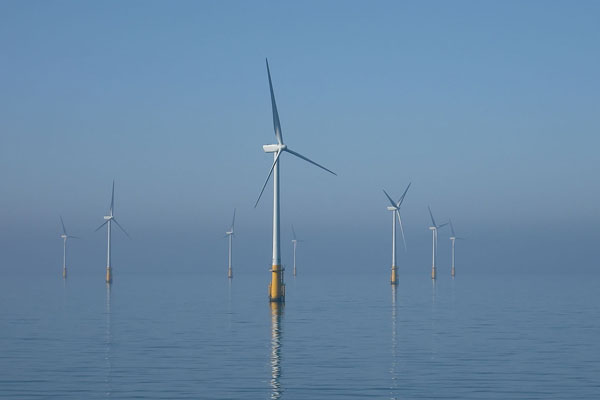
Offshore wind power
UD professors say nation has fallen behind on offshore wind power
4:13 p.m., Sept. 28, 2015--University of Delaware faculty from the College of Earth, Ocean, and Environment (CEOE), the College of Engineering and the Alfred Lerner College of Business and Economics say that the U.S. has fallen behind in offshore wind power.
The UD professors, who are all affiliated with UD’s Center for Carbon Free Power Integration (CCPI), reported their findings in an invited paper that appeared this week in the prestigious journal Proceedings of the National Academy of Sciences.
Research Stories
Chronic wounds
Prof. Heck's legacy
Titled “The Time Has Come for Offshore Wind Power in the U.S.,” the paper asserts that while offshore wind turbines have been successfully deployed in Europe since 1991, the U.S. is further from commercial-scale offshore wind deployment today than it was in 2005.
“As we celebrate the 10-year anniversary of the U.S. Energy Policy Act of 2005, it is disheartening to see that while land-based wind and solar have reached new heights, U.S. offshore wind has remained a missed opportunity,” says the paper’s lead author, Jeremy Firestone, who is a professor in CEOE’s School of Marine Science and Policy and directs CCPI.
Co-authors on the paper include:
- Cristina Archer, associate professor in the School of Marine Science and Policy;
- Meryl Gardner associate professor in the Department of Business Administration;
- John Madsen, associate professor in the Department of Geological Sciences;
- Ajay Prasad, Engineering Alumni Distinguished Professor in the Department of Mechanical Engineering and director of UD’s Center for Fuel Cell Research; and
- Dana Veron, professor in the Department of Geography.
Collectively, Firestone and his UD colleagues have decades of experience in offshore wind power research, teaching and policy advice.
Firestone contends that regulatory, tax and finance policy and planning changes, as well as a refocused research effort, are required to advance U.S. offshore wind development.
Offshore wind development, he says, is currently predicated on a model originally developed for offshore oil. But while offshore oil can be sold to refineries throughout the U.S. and its price is influenced by global markets, electricity from renewable energy such as offshore wind is tied to local markets and is part of a regional grid system.
“Electricity markets are different than oil and gas, it’s like trying to put a square peg in a round hole,” says Firestone.
Tax policy and financial incentives, including long-term tax credits for implementation, he continues, are important with projects like offshore wind, which are very capital intensive, as are loan guarantees.
Offshore wind power has tremendous potential to help the U.S. reduce its dependence on fossil fuels. By displacing coal and natural gas, offshore wind will reduce health costs and contribute to improved air quality and reduced climatic impacts.
Other motivations for offshore wind development include creating local manufacturing and other jobs, reducing common air pollutants, providing energy security and price stability, and improving U.S. economic competitiveness.
To help overcome current barriers to offshore wind implementation, the UD professors also advocate that research focus on impediments specific to the U.S.
“Given that research dollars are limited, it is important to target those funds to areas that will result the greatest value-added to the United States,” Firestone says.
For example, the United States experiences more extreme wind and wave loading due to hurricanes and northeasters, as well as icing in the Great Lakes areas, creating U.S. specific research opportunities.
Similarly, research aimed at better understanding the wind regime specific to the Atlantic Ocean’s Mid-Atlantic Bight — how windy it is and where — will provide important information about how much power can be generated in different segments of the ocean, which in turn affects prices that people would have to pay.
Social and cultural concerns of coastal residents also can impede offshore wind power development progress.
“Individuals often have deep and meaningful experiences with the ocean and long-standing ties to coastal communities, and as a result, may be resistant to changes to the coastal landscape. Attention also should be devoted to research that seeks to understand these social and cultural barriers to change,” Firestone notes.
To learn more about offshore wind research within UD’s Wind Power Program, visit the webpage.
Article by Karen B. Roberts
Photograph by Andy Dingley








